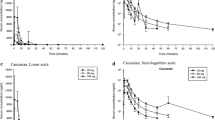Summary
The steady-state pharmacokinetics and tolerability of the α1-adrenoceptor antagonist alfuzosin were investigated in 12 healthy male volunteers aged 50 to 70 years using an open crossover design. Comparison of the pharmacokinetic profile in subjects receiving repeated doses of either 7.5 or 10 mg/day for 5 days did not reveal any differences except those related to the dose administered. The times to peak plasma concentrations (tmax) were not significantly different after sequence A (2.5mg at 0800, 1400 and 2000h) or sequence B (2.5mg at 0800, 1400 and 5mg at 2000h). The mean (± SEM) tmax after the 3 doses on day 5 were: treatment A, 2.0 ± 0.2, 1.4 ± 0.1 and 2.3 ± 0.3h, and treatment B, 1.9 ± 0.1, 1.9 ± 0.2 and 1.8 ± 0.2h. Peak concentrations following the first two 2.5mg doses, identical in both treatment sequences, were also not significantly different: treatment A, 10.4 ± 0.7 and 12.0 ± 0.9 μg/L, treatment B, 11.5 ± 0.9 and 11.4 ±0.8 μg/L (mean ± SEM). Cmax following the 2000h dose was significantly different (p = 0.0004) and in direct proportion to the larger dose: treatment A, 13.9 ± 1.0 μg/L; treatment B, 22.6 ± 1.7 μg/L (mean ± SEM). Similarly, the area under the plasma concentration-time curve (AUC) was significantly (p = 0.0001) greater with the larger dose: treatment A, 184 ± 13 and treatment B, 244 ± 19 μg/L/h (mean ± SEM). The ratio of the AUC values obtained following treatments A and B was 77.9 ± 2.5%, which corresponds to the ratio between the total dosages of treatments A and B, i.e. 75%.
Five of the 12 subjects who completed the study reported one adverse event each. Three subjects reported headache, one subject experienced dizziness when standing on 2 occasions, and another subject reported experiencing dry mouth. All adverse events resolved without treatment.
Comparison of the 2 dosage regimens did not reveal any significant differences relating to haemodynamic parameters.
Similar content being viewed by others
References
Babied G, Fauré M, Guillet Ph, Guinebault P, Bianchetti G, et al. Pharmacocinétique de l’alfuzosine chez le sujet agé. Synthélabo Recherche Internal Report, 1986 Beck H, Larribaud J, Guillet Ph, Caqueret C, Bianchetti G, et al. Pharmacocinétique de l’alfuzosine chez le sujet agé. Synthélabo Recherche Internal Report, 1988
Caine M, Perlberg S, Shapiro A. Phenoxybenzamine for benign prostatic obstruction. Urology 17: 542–546, 1981
Chilton CP, Morgan RJ, England HR, Paris AMI, Blandy JP. A clinical evaluation of the results of transurethral resection of the prostate. British Journal of Urology 50: 542–546, 1978
Dawling S, Crome P. Clinical pharmacokinetic considerations in the elderly: an update. Clinical Pharmacokinetics 17: 236–263, 1989
Duchier J, Cournot A, Bianchetti G, Rosen P, Dellac C, et al. Etude de Bioéquivalence de L’Alfuzosine. Synthélabo Recherche Internal Report, 1989
Gingell JC. Review of current and future approaches to the management of benign prostatic hyperplasia. Postgraduate Medical Journal 68: 702, 1992
Glynn RJ, Campion EW, Bouchard GR, Silbert JE. The development of benign prostatic hyperplasia among volunteers in the normative ageing study. American Journal of Epidemiology 121: 78–82, 1985
Guinebault P, Broquaire M, Colafranceschi C, Thénot JP. High performance liquid chromatographic determination of alfuzosin in biological fluids with fluorometric detection and large-volume injection. Journal of Chromatography 353: 361–369, 1986
Jardin A, Bensadoun H, Delauche-Cavallier MC, Attali P, the BPH-ALF Group. Alfuzosin for treatment of benign prostatic hypertrophy. Lancet 1: 1457–1461, 1991
Johnson RH. Orthostatic hypotension in elderly people. In Evans and Williams (Eds) Oxford textbook of geriatric medicine, pp. 526–537, Oxford University Press, Oxford, 1992
Meyrier A, Jardin A, Brossel S. Rapport d’experts concemant la documentation clinique alfuzosine — Dossier AMM. LERS Internal Report M.34.04.87.005, 1987
Perlberg S, Caine M. Adrenergic response of bladder muscle in prostatic obstruction. Its relation to detrusor instability. Urology 20: 524–527, 1982
Scott MG, Deering AH, McMahon MT, Haron DWG, Shanks RG. Haemodynamic and pharmacokinetic evaluation of alfuzosin in man. A dose ranging study and comparison with prazosin. European Journal of Clinical Pharmacology 37: 53–58, 1989
Singh M, Tressidder GC, Blandy JP. The evaluation of transurethral resection for benign enlargement of the prostate. British Journal of Urology 45: 93–102, 1973
Author information
Authors and Affiliations
Rights and permissions
About this article
Cite this article
Crome, P., Wijawardhana, P., Ankier, S.I. et al. Alfuzosin: A Comparison of the Steady-State Pharmacokinetics of Two Dosages in Middle-Aged and Elderly Healthy Male Volunteers. Drug Invest. 6, 156–161 (1993). https://doi.org/10.1007/BF03259736
Published:
Issue Date:
DOI: https://doi.org/10.1007/BF03259736




